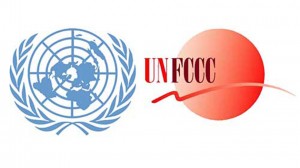Today, my class completed the “20th” Conference of the Parties to the UN Framework Convention on Climate Change. Groups of students representing 25 different countries worked feverishly to complete an agreement, submitting the final text with only a minute to spare.
The final product features many creative and detailed solutions to ongoing international climate policy disputes. Perhaps students should replace the delegates to the upcoming COP in Lima this fall!
Without further ado, here is the text of the Vancouver Accord, without the many bilateral side agreements:
OUTCOME OF THE MOCK 20th CONFERENCE OF THE PARTIES TO THE UN FRAMEWORK CONVENTION ON CLIMATE CHANGE
1. The parties of this convention agree with the findings of the Fifth Assessment of the Intergovernmental Panel on Climate Change that climate change represents a serious threat to the ecological and economic future of the planet.
2. A central goal of long-term collective action is the stabilization of greenhouse gas concentrations in the atmosphere at level that will keep global surface warming at minimum of 2°C above the pre-industrial average, contingent on the developed world providing financial and technical support to the developing world.
3. The Annex 1 nations agree to consider legally binding emissions targets of 25% below 1990 levels by the year 2020, with exception of economies in transition represented at this meeting by the Russian Federation. Further emissions targets will be set by an Ad Hoc Working Group, with a goal of developing countries and economies in transition committing to reduce the intensity of emissions and transitioning to acceptance of binding emissions targets by 2025. The Ad Hoc Working group must develop reasonable targets that ensure the safety and security of the economy of countries, including Saudi Arabia.
4. All parties to this convention should contribute to the effort to assist the developing world in responding to immediate and long-term effects of climate change, climate-related catastrophes, and sustainable development. A monitoring system needs to be implemented to make sure funds are used effectively.
5. Climate funds will be distributed on a success-based staggered payment schedule- funding based on success, with base funding for infrastructure development, and a goal of decreased UNFCCC management and involvement over time. Success will be defined by metrics like achieving emissions targets, developed by a third party auditor. Private sector funding may be encouraged via positive reinforcement policies, like decreased tariffs in exchange for increased emissions efficiency from companies. Funding promises should be legally binding, both fiscally and financially- tariffs and subsidies as incentives for signing.
6. Future Conference of the Parties shall address the specific payment calculation, including accounting for historic contributions, the lack of contribution from developing countries, and issues surrounding the specific sources of funding and the destination of funding.
7. To support mitigation efforts, the parties’ aspirational goal is to establish an international framework for a carbon market in which all countries can be involved. We agree to the 3-phase approach for all REDD initiatives, which is currently used in Norway’s REDD partnerships, in order to ensure consistency between all REDD partnerships. All emission reduction goals will be determined on a case-to-case basis, with a goal for all countries to be in phase 3 by 2020 and participants in a global carbon market. Specifics of this framework will include:
a. We aim towards an agreement between all nations that in order to be eligible to offset emissions by purchasing carbon credits from developing countries, developed nations will be required to reduce their domestic emissions from deforestation by an agreed upon amount. This amount will be determined on a case-to-case basis, depending on the size of the forestry sector of the economy. The United States, Australia, and China are hesitant to agree to law-abiding domestic emission reductions, but will work towards decreasing their own emissions in the future.
b. The structure of the Amazon Fund will be the model for all REDD initiatives and partnerships. Our goal is to finalize this structure to be applied to all current and future REDD partnerships to ensure international consistency.
c. We aim for increased financial contribution to Brazil’s INPE satellite effort for the monitoring of global deforestation. China will continue to work with Brazil on the CBERS, which is part of the INPE satellite effort, and urges other countries to financially contribute. Norway and Germany agree that Brazil will use part of the Amazon Fund for further development of the INPE, as well as education and capacity building programs to educate local communities on deforestation.
8. Regardless of the actual pledged dollar amount, all countries in attendance agree to legally binding timeline between pledges and dispersal. These would be subject to “waves” whereby targets would be reached and another set of funding dispersed to ensure efficiency of spending.
9. The Annex I nations (excluding Russia) the UK, France, Japan, Australia and USA are willing to commit funding to a third party such as the World Bank to manage possible funds under the Warsaw International Mechanism for Loss and Damage. They will decide how to allocate funds further, with priority going towards least developed countries before developing nations. Annex I countries request for the funds to come predominantly in the form of grants. Australia is in accord with the UK, France and Russia in allocating more uranium and resources to develop nuclear energy infrastructure.
10. The Mechanism will include alternate funds for technology development, disaster mitigation and education. Countries that will suffer negative economic impacts are permitted to receive funding in order for economic diversification through infrastructure and education. These countries include Russia, Saudi Arabia, Chile and Nigeria.
11. Future Conferences of the Parties should address issues including intellectual property rights for technology and healthcare, full separation of technology development, disaster mitigation and education funds, and guaranteed increases in funding towards insurance policies for least developed countries.

